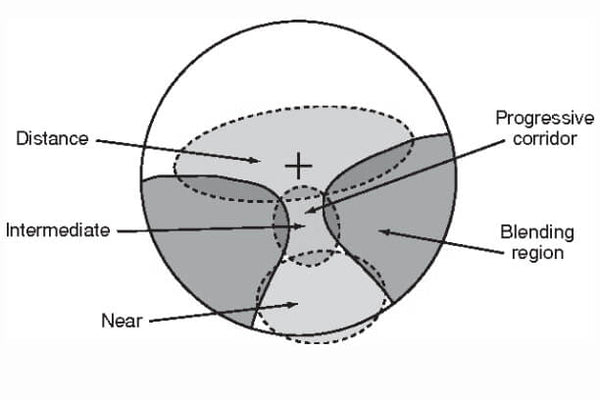
Progressive Lenses – Why you need them?
As a glasses wearer, you’re probably used to owning and switching between eyewear to solve your myopia. It is common to have a few styles of frames to wear daily and leave a pair of prescription sunglasses in the car. However, as your near vision deteriorates with age, you will find you need an additional pair of readers to fit your daily vision needs and start switching or taking off your glasses multiple times a day. This inconvenience can be solved by progressive lenses.
In this article, we will look at what progressive lenses are, how they work, their advantages, and how to choose a suitable option for you.
What are progressives lenses?
In contrast to the common single-vision lens which has one optical center to correct either distant or near vision, progressive lenses are multifocal lenses that have two optical centers to correct distant, intermediate, and near vision zones in one lens.
Different from bifocals, which have a small lens fitted to correct distant and near vision zones, progressive lenses do not possess this discrete ‘jump’ in power but rather are designed with a channel of continuous powers to create a gradual transition in switching between distant, intermediate and near vision, making it smooth and more comfortable to use.

Are progressives for me?
If you have a prescription and need corrective eyewear for more than one area of vision, then progressive lenses will simplify your life massively. This is most seen in people who have single vision requirements but age to need reading glasses for their presbyopia. In this case, the progressive lenses will be tailored to fit both your near and far prescriptions.
In recent years, an increasing number of people have chosen progressives to ‘relax’ the eye while using near vision. Most myopia glasses wearers can see clearly without glasses within a certain vision, the prescription we are given is for vision at a certain far distance. If we use the same distant prescription while using near vision, this prescription will be overcorrecting, thus weakening the power at a close distance will relax the focus of the eye. In this case, you commonly fit your distance prescription and choose between a range of progressive designs.
What do I need to buy progressive lenses?
If you wish to fit a progressive lens to correct your distant, intermediate, and near vision in one lens, you will need to ask for a comprehensive eye exam which should test both your near and far correction needs. This may be shown on your prescription as far vision Rx and an ‘ADD’, or the combination of far Rx and near Rx. Whichever way, each Rx should include your SPH, CYL, and axis for both eyes and pupillary distance for both near and far vision.
How to choose a suitable lens?
-Your lifestyle
Progressive lenses come in all sorts of functions, NextPair offers daily wear clear lenses, digital protection lenses, and light-adjusting lenses; to fit your lifestyle needs.
-Your Rx
If you have a strong prescription, whether in near or far vision zones, it is recommended you choose a higher index lens material for a thinner look and lightweight experience. NextPair offers a full range of lens materials from 1.60 impacts resistant PC to ultra-thin 1.74, and an additional handcrafted lens-thinning technology for selection.
-Your budget
Progressive lenses are often more expensive than single-vision lenses, as each pair is made one-by-one to fit each different and complex prescription. However, there are many good-for-value choices and brands to choose from. For example, NextPair lenses are manufactured in an factory and sent to our customers without any middleman. As a result, the progressive lenses are luxury grade but accessible at factory prices.
What to expect from your first pair
It is common that progressive lenses are harder to adapt to than single-vision lenses, the time may vary from a week to a couple of months. During this time, your eye will adapt and learn the comfortable way to use the progressive lens. The adaption time will largely decrease if you have not only an accurate, but more importantly comfortable prescription; so it is essential to undergo a comprehensive eye exam from a licensed optometrist and keep in contact to discuss any discomfort whilst adapting to your first pair of progressive glasses.
Summary
Progressive lenses are a comfortable solution for meeting your distant, intermediate, and near vision needs all in one lens, and are becoming increasingly popular. In choosing a pair, you first need a comfortable prescription, and consider your lifestyle, prescription, and budget requirements. For your first pair, expect an adaptation period and keep close contact with your optometrist for a smooth transition. For more information, visit NextPair progressive lenses, or contact our 24-hour customer service anytime.
 titanium eyewear
titanium eyewear

 get discount
get discount loyalty program
loyalty program help online
help online